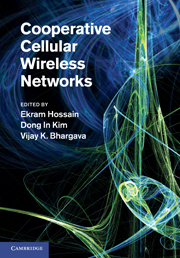Book contents
- Frontmatter
- Contents
- List of contributors
- Preface
- Part I Introduction
- Part II Cooperative base station techniques
- Part III Relay-based cooperative cellular wireless networks
- 6 Distributed space-time block codes
- 7 Collaborative relaying in downlink cellular systems
- 8 Radio resource optimization in cooperative cellular wireless networks
- 9 Adaptive resource allocation in cooperative cellular networks
- 10 Cross-layer scheduling design for cooperative wireless two-way relay networks
- 11 Green communications in cellular networks with fixed relay nodes
- 12 Network coding in relay-based networks
- Part IV Game theoretic models for cooperative cellular wireless networks
- Part V Standardization activities
- Index
7 - Collaborative relaying in downlink cellular systems
from Part III - Relay-based cooperative cellular wireless networks
Published online by Cambridge University Press: 03 May 2011
- Frontmatter
- Contents
- List of contributors
- Preface
- Part I Introduction
- Part II Cooperative base station techniques
- Part III Relay-based cooperative cellular wireless networks
- 6 Distributed space-time block codes
- 7 Collaborative relaying in downlink cellular systems
- 8 Radio resource optimization in cooperative cellular wireless networks
- 9 Adaptive resource allocation in cooperative cellular networks
- 10 Cross-layer scheduling design for cooperative wireless two-way relay networks
- 11 Green communications in cellular networks with fixed relay nodes
- 12 Network coding in relay-based networks
- Part IV Game theoretic models for cooperative cellular wireless networks
- Part V Standardization activities
- Index
Summary
Introduction
The deployment of relays in cellular system has been standardized in the WiMAX, IEEE 802.16j standard and is a topic of discussion in the advanced specifications of Third Generation Partnership Project (3GPP) long-term evolution (LTE). Although commercial relay deployments in cellular systems are not prominent at present, future wireless cellular systems will involve operation with dedicated relays to improve coverage, increase cell-edge throughput, deliver high data rates, and assist group mobility. The proposed architecture is such that relays would be placed at certain locations (planned or unplanned) in the cell to help in forwarding the message from the base station to the user in the downlink, and from the user to the base station in the uplink. Relays will be more sophisticated than simple repeaters and could perform some digital base band processing to help the destination terminal get better reception. These relays will rely on air interfaces, and hence avoid the considerable backhaul costs involving data aggregation and infrastructure costs associated with backbone connectivity. However, there are a lot of open issues that require research to answer.
Research challenges
Some of the major research issues in relay-based cellular systems are as follows:
(1) Throughput gains due to relay deployments In cellular networks that are coverage limited, deploying relays can help in multihop transmission and provide power gains due to a reduction of distance attenuation.
- Type
- Chapter
- Information
- Cooperative Cellular Wireless Networks , pp. 176 - 204Publisher: Cambridge University PressPrint publication year: 2011



